上海牛津英语四年级下4B语法总结
上海版牛津英语4B-语法总结之一——一般现在时
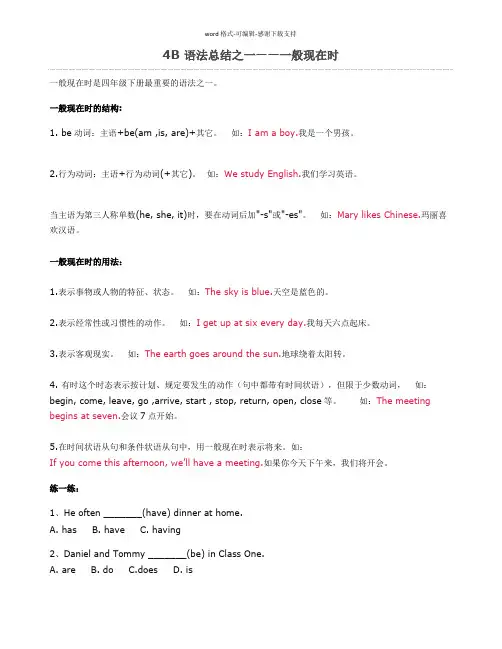
一般现在时是四年级下册最重要的语法之一。
一般现在时的结构:1. be动词:主语+be(am ,is, are)+其它。
如:I am a boy.我是一个男孩。
2.行为动词:主语+行为动词(+其它)。
如:We study English.我们学习英语。
当主语为第三人称单数(he, she, it)时,要在动词后加"-s"或"-es"。
如:Mary likes Chinese.玛丽喜欢汉语。
一般现在时的用法:1.表示事物或人物的特征、状态。
如:The sky is blue.天空是蓝色的。
2.表示经常性或习惯性的动作。
如:I get up at six every day.我每天六点起床。
3.表示客观现实。
如:The earth goes around the sun.地球绕着太阳转。
4. 有时这个时态表示按计划、规定要发生的动作(句中都带有时间状语),但限于少数动词,如:begin, come, leave, go ,arrive, start , stop, return, open, close等。
如:The meeting begins at seven.会议7点开始。
5.在时间状语从句和条件状语从句中,用一般现在时表示将来。
如:If you come this afternoon, we’ll have a meeting.如果你今天下午来,我们将开会。
练一练:1、He often _______(have) dinner at home.A. hasB. haveC. having2、Daniel and Tommy _______(be) in Class One.A. areB. doC.doesD. is3、The girl _______(teach) us English on Sundays.A. is teachingB. teachC. teachesD. teaching。
沪教版四年级英语下册(上海牛津4B)知识点总结
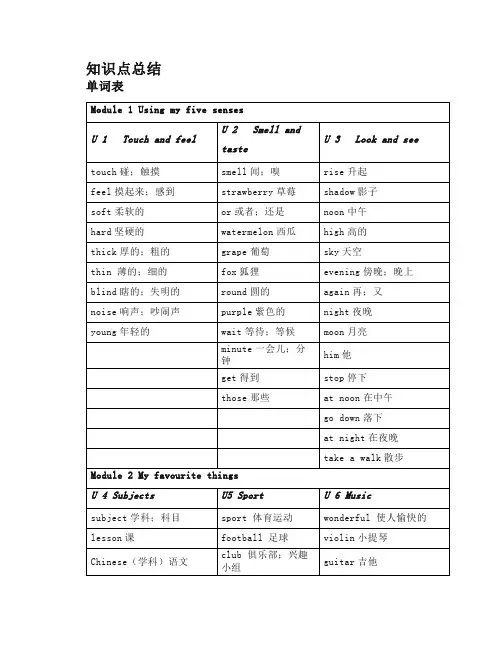
知识点总结单词表语法复习1. 量词的用法There is a glass of watermelonjuice.There are three glass es of strawberry juice.2. 选择疑问句和一般疑问句的区别(1) 一般疑问句Is thekite red and blue?(这风筝是蓝红色的吗?)一般疑问句的回答必须Yes或No开头 Yes, it is./No, it isn’t.(2) 选择疑问句Is thekite red or blue?(这风筝是蓝色还是红色?)选择疑问句的回答必须是二选一:It’s red.或It’s blue.3. 关于like后面接不同的名词和动词like apples / like green ones (可数名词复数)like the apple / like the green one (可数名词单数)likejelly(不可数名词)like dancing=like todance (动词)would like todance(would like to do=want to do)be like me/her/hisfather…(解释为像,作介词)4. 感叹句What nice grapes!(复数)What a nice girl!(单数)5. whose对所有格提问Whose bag is this?-----It’s peter’s.(this/that回答用it’s)Whose knives are those?-----They are hisknives. (these/those回答用they’re)6.so和too解释为如此、太时后面跟形容词It’s so thick. /He is so puzzled.It’s too noisy.7. How+助动词+主语+动词The pineapple is rough. (划线提问)Howdoes the pineapple feel?This cherry is sweet. (划线提问)How does this cherry taste?8.祈使句和can句型永远用动词原形,即使有now,也不能是进行时祈使句Let’s make a card now.Kitty, don’t put your book on the floor.(否定句在动词前加d on’t)can句型 Can Lucy read the book now?(容易犯的错误:看见Lucy一个人就用三单reads,或看见now用进行时)9. There be就近原则,后面所接词必须看清是否是可数名词从而确定be 动词There is a cat and two dogs. (离得近的是单数)There are two dogs and a cat. (离得近的是复数)There is some paper. (不可数)There are some paper rabbits. (前面有修饰的名词复数)There are some sheep. (单复数相同)There is some string. (不可数)There is a lot of apple juice. (前面有修饰的不可数)10. both和all 放在be动词之后,do动词之前We are bothtall.(be动词之后)They are allblind.(be动词之后)We both runfast.(do动词之前)The brothers all touch the elephant. (do动词之前)11. one of the 复数,谓语三单One of the boy s is Tom.say s one of the brother s12. 一般时和进行时的区别进行时:当句子里有标志性的词如now,look,listen,it’s…几点(祈使句和can句型除外),或是某个有上下情景的句子表示这个动作现在正在发生,结构be+doingListen, birds are singing.Where’s Sam? He is playing football outside.一般时:当句子里有标志性的词如every morning, on Moday, at weedends, always, usually, often,sometimes,n ever, at…几点等,表示陈述某个事实。
小学牛津英语4B知识点总结
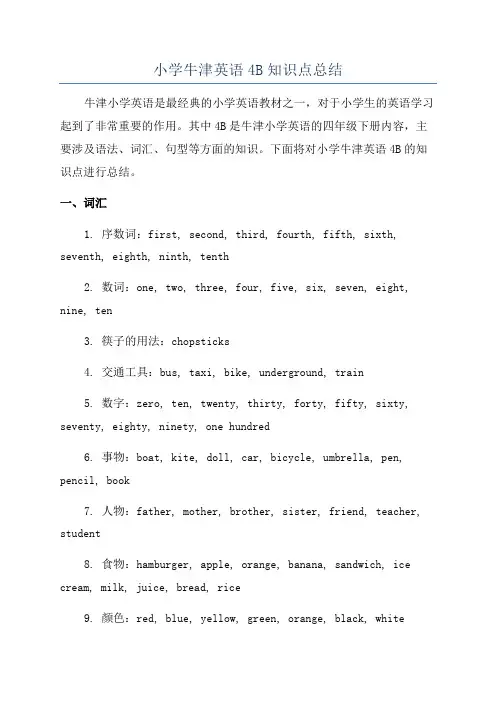
小学牛津英语4B知识点总结牛津小学英语是最经典的小学英语教材之一,对于小学生的英语学习起到了非常重要的作用。
其中4B是牛津小学英语的四年级下册内容,主要涉及语法、词汇、句型等方面的知识。
下面将对小学牛津英语4B的知识点进行总结。
一、词汇1. 序数词:first, second, third, fourth, fifth, sixth, seventh, eighth, ninth, tenth2. 数词:one, two, three, four, five, six, seven, eight, nine, ten3. 筷子的用法:chopsticks4. 交通工具:bus, taxi, bike, underground, train5. 数字:zero, ten, twenty, thirty, forty, fifty, sixty, seventy, eighty, ninety, one hundred6. 事物:boat, kite, doll, car, bicycle, umbrella, pen, pencil, book7. 人物:father, mother, brother, sister, friend, teacher, student8. 食物:hamburger, apple, orange, banana, sandwich, ice cream, milk, juice, bread, rice9. 颜色:red, blue, yellow, green, orange, black, white10. 音乐乐器:piano, violin, guitar, drums, flute11. 动物:dog, cat, monkey, panda, rabbit, bird, fish, elephant, tiger, lion12. 日期:Monday, Tuesday, Wednesday, Thursday, Friday, Saturday, Sunday二、语法1.一般现在时:主语+动词原形/第三人称单数现在时形式;e.g. I like music. He likes music.2. 物主代词:my, your, his, her, itse.g. This is my book.3.反意疑问句:陈述部分否定,疑问部分用否定的形式;陈述部分肯定,疑问部分用肯定的形式。
沪教版牛津英语小学四年级第二学期4B M1U2知识点
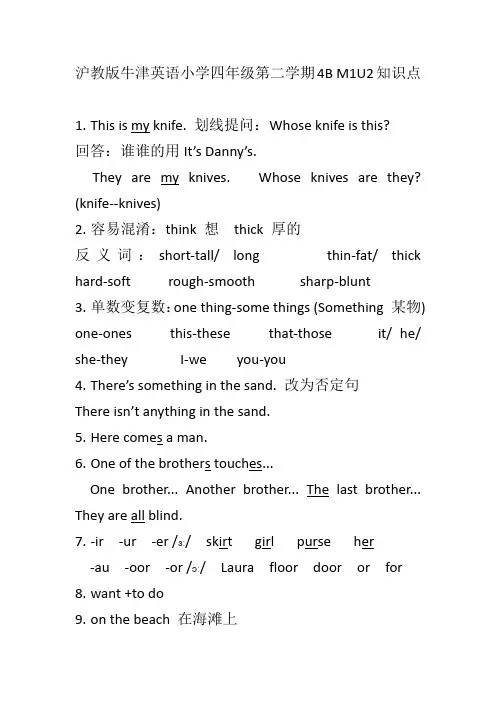
沪教版牛津英语小学四年级第二学期4B M1U2知识点1.This is my knife. 划线提问:Whose knife is this?回答:谁谁的用It’s Danny’s.They are my knives. Whose knives are they? (knife--knives)2.容易混淆:think 想thick 厚的反义词:short-tall/ long thin-fat/ thick hard-soft rough-smooth sharp-blunt3.单数变复数:one thing-some things (Something 某物) one-ones this-these that-those it/ he/ she-they I-we you-you4.There’s something in the sand. 改为否定句There isn’t anything in the sand.5.Here comes a man.6.One of the brothers touches...One brother... Another brother... The last brother... They are all blind.7.-ir -ur -er /ɜː/ skirt girl purse her-au -oor -or /ɔː/ Laura floor door or for8.want +to do9.on the beach 在海滩上10.My pencil caseThis is my pencil case. It’s very beautiful. You can see many sheep on it. It’s very useful. There are some rubbers, a ruler and some pencils in it. I can use my pencils to write. I like my pencil case very much.。
上海牛津英语四年级下4B句型语法
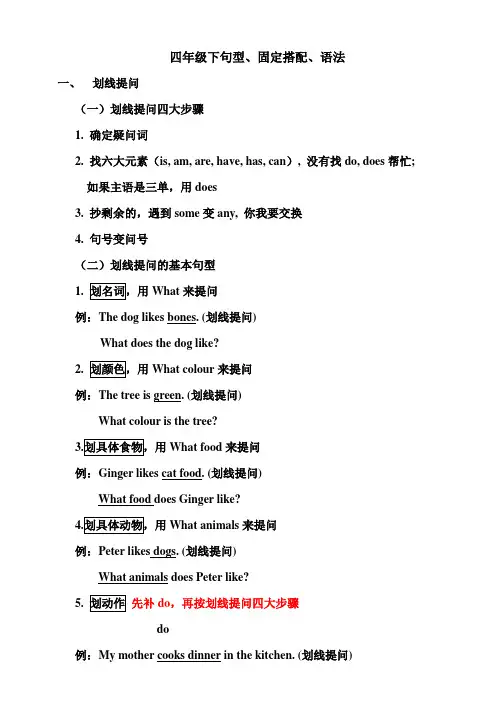
四年级下句型、固定搭配、语法一、划线提问(一)划线提问四大步骤1. 确定疑问词2. 找六大元素(is, am, are, have, has, can), 没有找do, does帮忙;如果主语是三单,用does3. 抄剩余的,遇到some变any, 你我要交换4. 句号变问号(二)划线提问的基本句型1. What来提问例:The dog likes bones. (划线提问)What does the dog like?2. What colour来提问例:The tree is green. (划线提问)What colour is the tree?What food来提问例:Ginger likes cat food. (划线提问)What food does Ginger like?What animals来提问例:Peter likes dogs. (划线提问)What animals does Peter like?5. 先补do,再按划线提问四大步骤doWhat does your mother do in the kitchen?6. 先补doing,再按划线提问四大步骤例1:doingMy mother is cooking dinner in the kitchen.(划线提问)What is your mother doing in the kitchen?例2:doingPeter likes eating fish. (划线提问)What does Peter like doing?7. 用Where来提问例:Peter is cooking in the kitchen. (划线提问)Where is Peter cooking?8. Who来提问例:Peter is cooking in the kitchen. (划线提问)Who is cooking in the kitchen?9. Whose+名词来提问例:That big football is Peter’s.Whose big football is that?10. 用How来提问例:She is hungry. (划线提问)How does she feel? = How is she?11. How many+名词复数,不可数用How much+不可数来提问例1:There is one apple on the table. (划线提问)How much food is there on the table?12. How much来提问例:These apples are four yuan. (划线提问)How much are these apples?13. How old来提问例:Peter is one year old. (划线提问)How old is Peter?14. When/ What time 来提问例:It is seven o’clock. (划线提问)What time is it?二.改成一般疑问句(一)一般疑问句基本步骤(比划线提问少确定疑问词这一步)1. 找六大元素(is, am, are, have, has, can),没有找do/does, 如果主语是三单,用does2. 抄剩余的, 遇到some变any, 你我要交换3. 句号变问号例1:Peter has got a new car. (改成一般疑问句)Has Peter got a new car?例2:Peter is washing hair in the bathroom. (改成一般疑问句) Is Peter washing hair in the bathroom?例3:Peter can cook dinner. (改成一般疑问句)Can Peter cook dinner?例4:Peter likes eating oranges. (改成一般疑问句)三.改否定句1. 在六大元素后面加not或n’t,没有六大元素在动词前面加don’t或doesn’t, 动词变原形2. 遇到some 变any,and变or例1:There is some food on the table. (改成否定句)There isn’t any food on the table.例2:Peter likes eating oranges. (改成否定句)Peter doesn’t like eating oranges.例3:Please taste some cherries. (改成否定句)Please d on’t taste any cherries.四.第三人称单数(三单)(一) 三单除了I和you 之外的所有单数都是第三人称单数,其后面的动词用三单形式,加s或es(二) 三单形式1. 一般情况下,动词+s , 如:plays, swims, cooks,2. 以s, x, sh, ch, o 结尾的动词加es, 如:3. 以辅音+y 结尾,去y加ies,如fly—flies, study—studies4. 不规则:have—has例1:Peter plays (play)badminton in the badminton club.例2:Peter’s mother washes (wash) her hair in the bathroom.例3:The butterfly flies (fly) in the park.例4:Peter has (have) a cat.五. 动词ing(一) 动词ing的形式1. 一般情况下动词后面直接加ing2. 以不发音e结尾,去e加ing如:dance—dancing,have—having,make—making,write—writing3. 最后只有一个辅音,中间只有一个元音,且元音不发自己的音,双写加ing。
上海牛津版4b英语语法知识
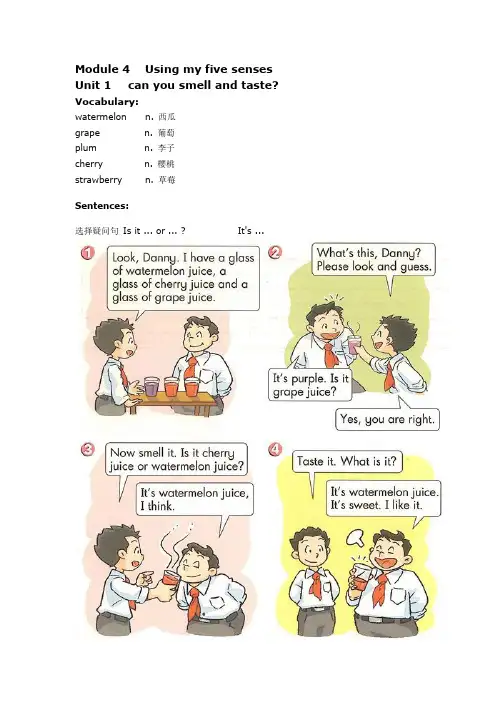
Module 4 Using my five senses Unit 1 can you smell and taste? Vocabulary:watermelon n. 西瓜grape n. 葡萄plum n. 李子cherry n. 樱桃strawberry n. 草莓Sentences:选择疑问句Is it ... or ... ? It's ...练习句型:用适当的词,替换以下句子中红色的部分:A: What do you have?B: Close your eyes. Smell it. Is it a peach or an apple? A: It's an apple, I think.B: Now taste it. How does it taste?A: It's sweet and nice.B: What is it?A: It's an apple.练一练:1、Do you like red apple___green apple?A. andB. butC. or2、-How does the red apple ___? -It's sweet.A. look likeB. smellC. tasteModule 4 Using my five sensesUnit 2 How does it feel?Vocabulary:本课的单词全都是形容词,同一行列出的是一组反义词。
hard softrough smoothsharp bluntthick thinSentences:1. Whose ... is this / that / are these / those? It's / They're ...2. Put your pencil in the bag.Put your ball in the bag.Put your toy bear in the bag.练一练:1、Whose pencils ___ ___?A. are theseB. is thisC. these areD. this is2、______ books in the bag.A. PutB. Put yourC.You putModule 4 Using my five sensesUnit 3 Look at the shadow!Vocabulary:hill n. 小山lawn n. 草坪path n. 小路bench n. 长椅Sentences:It ... (does)练一练:In the morning, the sun rises ___ the hill. The tree's shadow is ___.A. behind, longB. in front of, shortC. in, longModule 2 My favourite thingsUnit 1 SportsVocabulary:play football踢足球play table tennis打乒乓球play volleyball打排球play badminton打羽毛球play basketball打篮球Sentences:Does... like... (doing)?Yes, ... does. / No, ... doesn't.Danny: Look at that poster, Peter. There's a new club in our school. It's a badminton club. Do you like playing badminton?Peter: Yes, I do. It's my favourite sport.Danny: Me too. Let's join the club together, then.Peter: Great! Who else would like to join?Danny: Let me see. Does Alice like playing badminton?Peter: Yes, she does! She often plays badminton with me. Let's go and ask her. --------------------------------------------------------------练一练:1、Does Kitty like ___ volleyball?A. playB. playingC. plays2、___ your father like play football?A. DoB. DoesC. HasD. HaveModule 2 My favourite thingsUnit 2 Cute animalsVocabulary:bone骨头cat food猫粮parrot鹦鹉fish鱼dog food狗粮tortoise乌龟Sentences:What does ... (do)?... (does)...更多例句:A: What animals do you like?B: I like cats.A: What food does a cat eat?B: It eats fish.---------------------------------------------------------------练一练:1、What food ___ a dog like?A. didB. doC. doesD. 不填2、___ a cat like fish?A. DidB. DoC. DoesD. WhatModule 2 My favourite thingsUnit 3 Home LifeVocabulary:bedroom n. 卧室living room n. 客厅,起居室bathroom n. 浴室,卫生间kitchen n. 厨房Sentences:... am / is / are ... (doing): 是一个现在进行时的句子,表示某人正在做某事。
上海小学英语四年级(下)4B全笔记
上海小学英语4B笔记M1U11.sense 感觉2.smell 嗅3.taste 尝 taste with the tongue(舌) taste buds味蕾4.fell 触5.see 看见6.hear 听见7.sour sour8.taste (1)尝(2)味道(3)品味9.I see with my eyes.= I use(使用) my eyes to see.10.Look and see11. listen and hear12. touch and feel13. What have you got? (What do you have?)14. What has he got? (What does he have?)1.One 那些东西(单)2.ones 那些东西(复)3.the 形 one/ones4.Which one/ones?哪个/那些5.I like the big one. Which one do you like?6.I like the big one. What do you like?7.How about 怎样 = What about8.(1) How about you? = and you?(2) How about + doing? 提建议1. wing 翅 beak 鸟嘴2. vine 藤3. What nice grapes!感叹句:多么……啊!4. What + a/an + 形容词 + 名词!5. at all 根本6. I don’t like it at all.7. 感叹句: How + 形 + 句子剩余!8. How nice the grapes are!9. What a all tree!= How tall the tree is!10. What sweet apples!= How sweet the apples are!11. How does it taste?do they12. around 围绕13. enjoy 享用/欣赏 enjoy 喜欢 + doing14. in the afternoonOn sunny afternoons (具体到某一天时,用介词on 这里是多个晴朗的下午,所以用复数,加s)M1U21.厚的薄的thick 反义 thin粗的细的2.Whose … is this/that/it?It is …3.Whose … are these/those/they?They are …4.Who’s 谁是 Whose 谁的5.thing 东西[θɪŋ]thin [θɪn]6.slim 苗条的7.over there 在那边8.just 刚好1.at the beach 在海边2.on the beach 在海滩上3.at the seaside 在海边4.sand 沙子(不可数)5.take off shoes 脱下鞋take shoes offtake them off6.put on the coat 穿上外套put the coat onput it on7.of cause = sure 当然8.something(sth.)某样东西(单)9.something hard 某样硬的东西10.a key (钥匙)to the door11.a key (重点) school12.key (键)13.take(拿走,带走)sth.(物) to sp.(地方)14.lose(丢失的)15.property (财物)16.blind 瞎的17.colour blind 色盲的18.deaf 聋的19.dumb 哑的20.each part (部分)21.the whole (整体)22.tusk 象牙23.trunk 象鼻24.Don’t judge [dʒʌdʒ](评判)one thing by its part1.be like 像2.Its body is like the wall(墙).3.One of the + 复数M1U31.shadow 影子2.light 光3.hill 山丘4.rises 上升反义goes down 落下5.bench 长凳6.path [pɑ:θ]小径wn [lɔ:n] 草坪8.at sunrise 日出at sunset 日落9.get(变得)longgrow10.again 再,又11.chase 追赶 = run afterM2U11.sport shoes2.sports meeting (运动会)3.do sports 做运动4. a kind of sport (种类)5.ball games:6.volleyball [ˈvɒlibɔ:l] 排球7.baseball [ˈbeɪsbɔ:l] 棒球8.table tennis 台球(乒乓)9.badminton 羽毛球10.tennis 网球11.golf 高尔夫球12.bowling 保龄球13.polo 水球14.hockey 冰球15.play ball games16.play with a ball17.play football18.球类前无 the,a,an19.in the spare(空余时间) time = in the free time1.hobby 爱好 hobbies2.my hobby is ing.有趣的(形) It’s fun。
上海最新牛津英语4B知识点梳理
4B知识点梳理Module1 Using my five sensesUnit1: What can you smell and taste?单元导学:本单元学习如何用英语表达嗅觉和感觉以及一些我们喜欢的水果名称,掌握选择疑问句的用法。
要点梳理:词汇:a glass of, watermelon, grape, plum, cherry, strawberry, juice句型:1.What’s this, Danny? What do you have? What do you like?2. It’s watermelon juice. It’s sweet and nice.3. How does it taste? Please look and guess.4. I have a glass of watermelon juice…语法知识:选择疑问句:Is it cherry juice or watermelon juice?Do you like plums or strawberries?日常用语:1. Yes,you are right.2. …, I think.3. How about…?4.Yum!Unit2: How does it feel?单元导学:本单元学习如何用英语表达触觉。
需要掌握与触觉相关形容词的用法以及名词所有格和由whose引导的特殊疑问句的用法。
要点梳理:词汇:hard , soft, rough, smooth, sharp, blunt, thick, thin, knife, pencil, pencil case 句型:1.Whose… is this/that? Whose … are these/those?2. It’s Danny’s. They’re Peter’s.3. Can I take off my shoes?4. Let’s ask the man over there.语法:1.名称所有格:It’s Jill’s. They’re Miss Fang’s.2.指示代词this, that, these和those的用法日常用语:1. Ouch! 2. Yes, of course you can.Unit3. Look at the shadow!单元导学:本单元学习一般现在时的基本用法以及一些常见介词的用法。
上海牛津英语四年级4B每单元知识点归纳
牛津小学英语4B单元知识点归纳4B Unit1 A new student一、单词及词组1. a student(学生)2. a teacher(教师)3. a doctor(医生)4. a nurse(护士)5. a boy(男孩)6. a girl(女孩)7. a man(男人)8. a woman(女人)9. new(新的)10. our(我们的)11. school(学生)12. welcome(欢迎)13. tree(树)14. climb(攀登)15. again(再;又) 16. sir(先生)17. right(正确的) 18. come down(下来) 19. excuse me(对不起,打扰一下)二、缩写词1. who’s = who is2. you’re = you are3. he’s = he is4. she’s = she is5. I’m = I am6. don’t = do not三、句型1. Who’s that boy/…?(那个男孩/…是谁?)He’s/She’s ××. (他/她是××。
)He’s/She’s a…(他/她是一位…)2. Are you a student/…?(你是一位学生/…吗?)Yes, I am.(是,我是的。
)No, I’m not. I’m a…(不,我不是的。
我是一位…)3. Welcome to our school.(欢迎到我们学校来。
)Thank you.(谢谢。
)Unit2 At a party一、单词及词组1. grandfather(祖父;外祖父)2. grandmother(祖母;外祖母)3. father(父亲)4. mother(母亲)5. brother(兄;弟)6. sister(姐;妹)7. hair(头发)8. a head(头)9. a nose(鼻子) 10. a mouth(嘴;口)11. an eye(眼睛)12. an ear(耳朵) 13. white(白色的)14. a friend(朋友)15. a skirt(短裙) 16. a party(宴会) 17. with(有) 18. which(哪一个)19. big(大的) 20. small(小的) 21. long(长的)22. short(短的)23. we(我们)24. hurry(赶快) 25. wrong(错误的) 26. be late for(…迟到)二、缩写词1. we’re = we are2. isn’t = is not3. it’s = it is4. let’s = let us5. where’s = where is三、句型1. Who’s the man/… with …?(那个…(身体部位)的…(男人/…)是谁?)He’s/She’s ××/my…(他/她是××/我的…)2. Is that man/… your father/…? (那个男人/…是你爸爸/…吗?)Which one?(哪一个?)The one in the …(那个穿着…的。
上海牛津英语4B知识点
上海牛津英语4B知识点一、词汇知识点1.数字词:- 纯数字:one, two, three, four, five, six, seven, eight, nine, ten, eleven, twelve, thirteen, fourteen, fifteen, sixteen, seventeen, eighteen, nineteen, twenty, thirty, forty, fifty, sixty, seventy, eighty, ninety, hundred, thousand.- 基数词及序数词:first, second, third, fourth, fifth, sixth, seventh, eighth, ninth, tenth, eleventh, twelfth, thirteenth, fourteenth, fifteenth, sixteenth, seventeenth, eighteenth, nineteenth, twentieth.2.复数形式:- 一般规则:在名词后面加-s,如dogs, cats.- 特殊规则:以s, x, ch, sh结尾的名词加-es,如boxes, churches.- 不规则变化:如man-men, tooth-teeth, mouse-mice.3.形容词比较级和最高级:- 比较级:形容词或副词+er (如bigger, faster),或者在前面加more (如more beautiful).- 最高级:形容词或副词+est (如biggest, fastest),或者在前面加most (如most beautiful).1.一般现在时:-表示经常性的动作或习惯,一般情况下的真理,或现在的状态。
- 主语+动词原形,如I play basketball every day.2.一般过去时:-表示过去一些时间发生的动作或状态。
- 1、下载文档前请自行甄别文档内容的完整性,平台不提供额外的编辑、内容补充、找答案等附加服务。
- 2、"仅部分预览"的文档,不可在线预览部分如存在完整性等问题,可反馈申请退款(可完整预览的文档不适用该条件!)。
- 3、如文档侵犯您的权益,请联系客服反馈,我们会尽快为您处理(人工客服工作时间:9:00-18:30)。
上海牛津英语四年级下4B语法总结冠词/不定冠词:➢不定冠词:a/an 表示某一个a辅音开头的名词前an元音开头的名词前an + apple 、orange、egg、elephant、insect 、umbrella、old、hour、honest➢定冠词:the表示特定的这个或那个the sun定冠词the用于特指、独一无二(the sun)、形容词最高级、序数词、海洋江河山脉岛屿等专有名词(the Yangze River)、方位词、乐器(play th piano)、时间(in the morning)➢零冠词:球类运动(play football)、时间(at night)、季节月份星期(in spring ,in September, on Monday)、名词复数:➢一般情况,单词变复数只需加s,如book—books, friend→friends; cat→cats➢凡是以s、ss, z、x、ch、sh或o结尾的词,后面只需加es。
如;bus→buses;fox→foxes;等。
➢结尾以y ,而y之前是元音字母的话,只需加s 就行了。
如;toy—toys、boy—boys.如果y前是辅音,去y加ies➢以-f或-fe结尾的名词,多为将-f或-fe改变为-ves。
例:knife→knives; life→lives;leaf→leaves。
反例:roof→roofs➢以o 结尾的词,有生命加es 如;potato--- potatoes。
但没有生命的加s (除个别特殊的)➢不规则变化单词child---children tooth---teeth man…men woman…women mouse…mice foot…feet➢单复数相同的词;fish sheep deer ……➢如果是不可数,例如液体,粉状的没有单复数形式。
如water milk jam meat flour rice power paper cloud honey sugar rice bread salt air juice pepper grass work句子时态表示现在情况的有一般现在时和现在进行时。
动词的形式;动作可以在不同时段发生,如:现在发生、过去发生、现在正在进行中和动作已经完成等。
动词的形态要跟随动作发生的时间而改变,称时态。
标点符号;写文章时,标点符号是不可缺少的。
一般现在时谓语是系动词be(表示是):➢am:主语I后用, I am。
➢Are:主语是1)两个以上的物品有生命的2)you we they those these 时用➢is: 主语是1)单个物品或单个有生命的或不可数的2)he she it this that时用谓语是动词➢主语是1)单个人或物时2)he\she\it\this\ that时,反义词:down - up open – close come – go ask – answer hot – cold cool – warm dry – wet young – old new – old tall –shorthigh-short good-bad yes-no fat-thinwhite--backbig-small left-right smooth-rough hard-soft in-out on-under black-white come-go sit down-stand upthis-that these-those同音词:see — sea know — no there — their deer — dearpear — pair where – wear meat – meet buy – by - byewrite — right for — four sun — son hear---hereflower-flour our – hour be – bee week - weaktwo-too-to eye-I pear – pair whole – holeweather – whether mail – male steal – steeltail – tale hair – hare aren’t – aunt father – fartherone – won through – threw would – wood new – knewwhose – who’s its – it’s ours - hoursThere be句型:跟be动词解释差不多,只用看be动词后紧跟着的名词是单数还是复数了。
紧跟的是单个或不可数则用is,紧跟的是多个则用are用法:There be句型一般表示地方或存在某物。
动词be的单复数形式要跟There be之后的主语保持一致,并且根据就近一致原则来变化。
句子结构:主语谓语宾语主语;指人、事件或事物等,是一句话的中心。
谓语;描述主语是什么、做什么事或主语有什么感受等。
主语和谓语的位置;习惯上主语在句前,谓语在后,但有时会例外。
主语一般是名词或主格代词;谓语一般是be动词或动词;宾语一般是名词或宾格代词为第三人称单数,谓语动词要加s1)多个人或物时用2)you\we\they\ those\ these时动词不变Have/has是谓语动词(表示有):➢has:主语是1)单个人或物时2)he\she\it\this\ that时用。
➢Have:主语是1)多个人或物时用2)you\we\they\ those\ these时用。
动词加S的变化规则一般现在时中第三人称单数情况下谓语动词要加s1)一般直接加s2)以s,x,ch,sh,o结尾的加es3)动词词尾是辅音字母+y的,去“y”后加“ies”,若是元音字母+y,直接加s:改句式:改成否定句、一般疑问句和划线部分提问注意肯定句中some在否定句中要改成any, 肯定句中and在否定句中要改成or➢有am,is,are,can,will的句子一般疑问句: Am,Is,Are,Can,Will+主语+原句内容照抄?回答:Yes/No, 主语+am,is,are,can,will否定句:主语+am,is,are,can,will+not+原句内容照抄.特殊疑问句:特殊疑问词+ am,is,are,can,will+主语+原句内容照抄?➢谓语是动词时1)主语是单个人或物时或主语是he\she\it\this\ that时,一般疑问句:把does放最前面,同时动词去掉s恢复动词原形;Does+主语+动词原形+原句其它内容照抄?否定句:加does not(doesn’t),同时动词去掉s主语+ does not(doesn’t)+ 动词原形+原句其它内容照抄特殊疑问句:特殊疑问词+does+主语+动词原形+原句其它内容照抄? 2)主语是多个人或物时用或主语是you\we\they\ those\ these时,一般疑问句:把do放最前面,同时动词不变;Do+主语+动词原形+原句其它内容照抄?否定句:加do not(don’t),同时动词不变主语+ do not(don’t)+ 动词原形+原句其它内容照抄特殊疑问句:特殊疑问词+do+主语+动词原形+原句其它内容照抄?➢has,have表示“有”时,一般疑问句:has的句子把does放最前面,同时has改成have;Does +主语+have+原句其它内容照抄?have的句子把do放最前面Do+主语+have+原句其它内容照抄?否定句:has的句子加does not(doesn’t),同时has改成have;主语+ does not(doesn’t)+ have+原句其它内容照抄have的句子加do not(don’t)主语+ do not(don’t)+ have+原句其它内容照抄特殊疑问句:has的句子特殊疑问词+does+主语+have+原句其它内容照抄?have的句子特殊疑问词+do+主语+have+原句其它内容照抄?表示“有”的have/has在口语中也常用have got/has got来表示,这里的have、has是助动词,got是get(得到)的过去式。
比如He has a sweater. He has got a sweater.I have a shirt. I have got a shirt.表示“有”时,除按前面用助动词do、does来构成否定句、疑问句外,对have got/has got的,可在have/has后直接加not构成否定句,如I have not got a shirt. He has not got a sweater.可将have/has放到最前面,Have/Has + 主语+ 原句照抄,比如Have I got a shirt?Has he got a sweater?划线部分提问When 对句子表示时间的部分提问,问“什么时候”Where 对句子表示地点、位置的部分提问,问“哪里”Which 有多个选择时,问“哪一个”What 对事和物提问,划线部分常是名词,问“什么”What shape 问“什么形状”What colour 问“什么颜色”Who 对主语部分,且主语是人,问“谁”How 问“怎么样”如感觉怎么样how….feel、吃起来怎么样how …taste、气色怎么样how are you?How ofen 对句中表示频率的词提问,表示频率的词有once ,twice等,问“多久一次“How much 对句子表示钱的部分提问,问“多少钱“How many 对句子表示数量的部分提问,问“多少“How long对句子表示距离的部分提问,问“多远“Why 对句子表示原因的部分提问,问“为什么“现在进行时主语+be+动词+ing 表示动作正在进行中,句子中常有now动词加ing(现在分词)的变化规则1) 大多数动词是直接加ing,如eating2) 以辅音字母加e结尾的动词去掉e加ing,如smile-smilingmake-making skate-skating write-writing3) 以重读闭音节结尾,末尾只有一个辅音字母的动词,要双写这个辅音字母加ing,如run-runnin swim-swimming sit-sitting4)以ie结尾重读开音节动词,改ie为y,加ing,如lie-lying die-dying补充:like to do 和like doing是一个意思用doing的情况1)需要用名词的场合,比如在动词后面做宾语或需要当作主语来用时,要把动词改成ing格式,这时是动名词2)现在进行时中be doing 3)介词后面也可用动名词代词代词是用来代替名词,分为人称代词、指示代词、疑问代词、不定代词、物主代词、关系代词。
